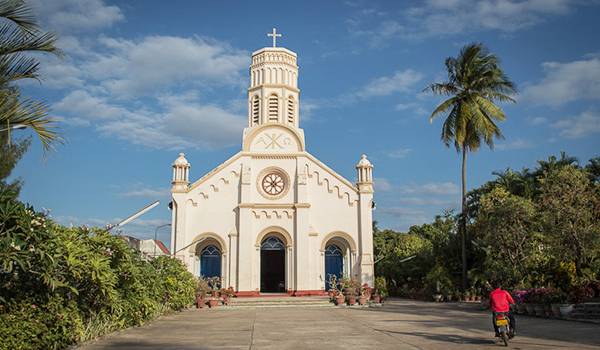
The diocesan area of 83,700 square kilometers covers Bokeo, Luang Namtha, Luang Prabang, Oudomxay, Phongsaly and Sainyabuli provinces.
The total population in the vicariate's territory is around 1.2 million. (The country as a whole has about 7 million people.) Ethnic Lao, Khamu and Tai are major groups.
Lao, Khamu, and many tribal languages and dialects are spoken.
Of the four apostolic vicariates in Laos, Luang Prabang is institutionally the weakest. The present Apostolic Administrator, Monsignor Tito Banchong Thopayong, was the only priest in the whole vicariate at the time of his appointment in April 1999. The only Catholic church in Luang Prabang was confiscated by the government following the 1975 revolution and has not been returned.
From the middle of the 13th century, the Lao tribes who had migrated from Southern China accepted Buddhism of the Theravada School as their religion. In popular Buddhism the traditional belief in guardian spirits (phi) and the wide-spread rites of ancestor veneration mingled with Buddhist beliefs. During the 18th and 19th centuries, the Kingdom of Laos was attacked repeatedly and dominated by its neighbour Vietnam. In 1893 the French entered Laos and made it a French protectorate. The Laotian kings lost more of their political power, but managed to retain many other privileges.
From 1630 onwards, Catholic missionaries made several attempts to enter Laotian territory and preach the Gospel. Most missionary endeavours, however, remained episodic, because they did not result in the establishment of a local Church. The first missionaries were Jesuits who reached Laos from Tongking (Vitenam).
The evangelization efforts of the missionaries of the Paris Foreign Mission Society (MEP), who came to Laos in 1878, were more successful. They succeeded in building up an indigenous Church in Laos. Dec. 8, 1885, the date on which they founded their first mission station, is traditionally accepted as the date of the birth of the Catholic Church in Laos. That mission station was established on Ban Dorn Don, an island in the Mekong river. The Apostolic Vicariate of Laos was founded soon after, in 1899.
Oblate Fathers (OMI) arrived in 1935 and concentrated their missionary work mostly in mountainous tribal areas in the north of the country.
The apostolic prefecture of Thakhek was established as a separate ecclesiastical unit In 1950, and raised to an apostolic vicariate in 1958, by which time the number of Catholics in Laos had reached 23,764. Nonetheless, the first local Laotian was ordained to the priesthood only in 1963.
A decade later, in 1974, the first Laotian bishop was ordained. Meanwhile, the Catholic Church in Laos had been restructured into four Apostolic Vicariates: Vientiane (1952), Luang Prabang (1963), Savannakhet (1963) and Pakse (1967).
The Laotian Constitution ratified in 1991 states that all Laotian citizens enjoy religious freedom.
Only in 1996 was the Catholic Church allowed to open a major seminary, in Thakek, where candidates from the minor seminaries of Paksan and Vientiane could continue their formation.
The Mekong river that runs along the western side of the territory is an important means of transportation. Roads are mostly in poor condition, with the mountainous terrain slowing travel further. The main road connects Luang Prabang town with Vientiane, the national capital. Luang Prabang town has an airport. Direct flights link with the main towns of Laos and also Bangkok and Hanoi.
Tropical monsoon with three distinct seasons -- hot (March-May), rainy (June-October) and cool (November-February).
Tourism in Laos is concentrated in this part of the country. The tourism industry, centered in Luang Prabang town, a UNESCO World Heritage site, is increasingly important in the local economy.
All newspapers are published by the government including an English-language and a French-language paper.
Mountainous with deep river valleys.